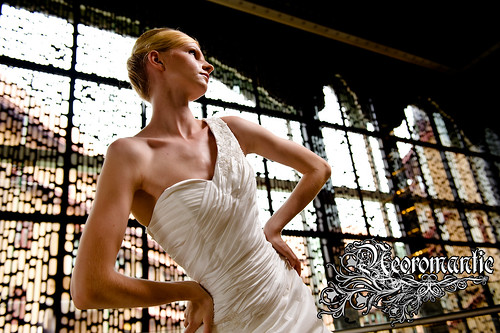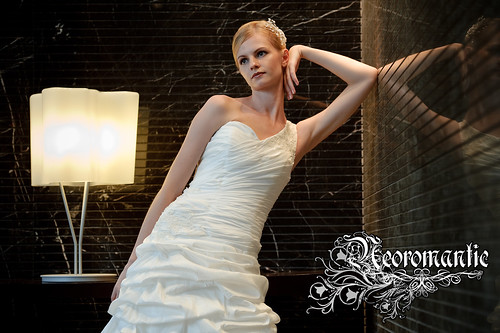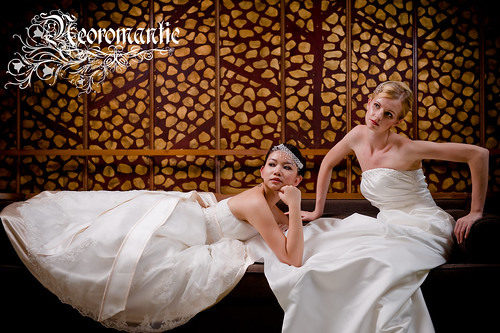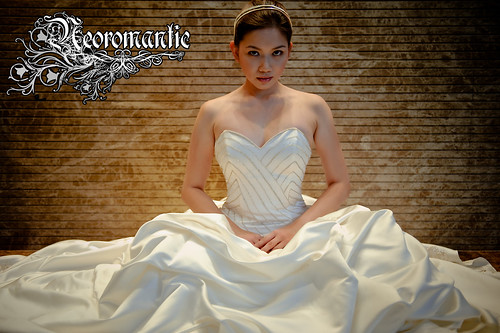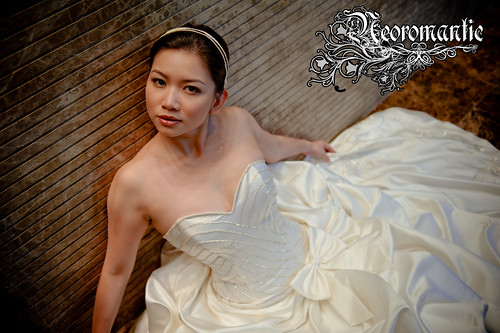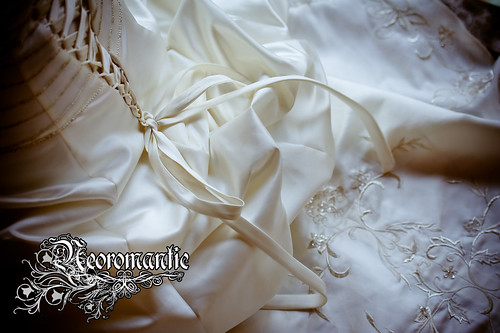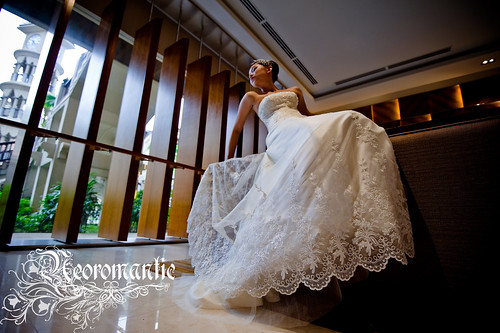How To Choose A Wedding Gown Design
Labels: Advice, Tips, Wedding Gowns
In choosing a design, there are 6 things you should keep your eye on:
Color: The color you select will depend upon your own coloring; dark-skinned brunettes look good in ivory or beige, and fair-skinned blondes may find they look better in a white pastel or pure white gown.
Length: The type of wedding you're having will affect your gown's length. Full-length gowns are fitting for formal weddings. At informal weddings, which are typically small in size and fanfare (and common for second, third, and fourth+ marriages), the bride can wear a knee-length skirt. The skirt should cover the knees and drape at least one inch below the top of the kneecap. Ankle-length is acceptable too, and it can be very classy, sexy, fashionable and romantic.
Silhouette: The "silhouette" refers to the shape of the gown and how it hugs your body. Popular styles include the Princess and A-line, ball gown (i.e., the Cinderella look), sheaths, a mermaid shape, an empire silhouette, or a two-piece.
Train: We suggest that if you want the long train, that it be detachable so that it won't get stepped on, torn, or otherwise ruined during the reception.
Mood: The mood of your dress can be Romantic, Modern, Traditional, or Classic.
Size: As with any other wardrobe selection, when it comes to picking a wedding dress, size does matter. For brides petite and large, the size of a bridal gown is ordered based on measurements of bust, waist, hips and height. Check this chart out to get an idea.
Color: The color you select will depend upon your own coloring; dark-skinned brunettes look good in ivory or beige, and fair-skinned blondes may find they look better in a white pastel or pure white gown.
Length: The type of wedding you're having will affect your gown's length. Full-length gowns are fitting for formal weddings. At informal weddings, which are typically small in size and fanfare (and common for second, third, and fourth+ marriages), the bride can wear a knee-length skirt. The skirt should cover the knees and drape at least one inch below the top of the kneecap. Ankle-length is acceptable too, and it can be very classy, sexy, fashionable and romantic.
Silhouette: The "silhouette" refers to the shape of the gown and how it hugs your body. Popular styles include the Princess and A-line, ball gown (i.e., the Cinderella look), sheaths, a mermaid shape, an empire silhouette, or a two-piece.
Train: We suggest that if you want the long train, that it be detachable so that it won't get stepped on, torn, or otherwise ruined during the reception.
Mood: The mood of your dress can be Romantic, Modern, Traditional, or Classic.
Size: As with any other wardrobe selection, when it comes to picking a wedding dress, size does matter. For brides petite and large, the size of a bridal gown is ordered based on measurements of bust, waist, hips and height. Check this chart out to get an idea.
Posted by
Neoromantic
on
Friday, November 21, 2008
0
comments
Wedding Gowns Sleeves
Labels: Tips, Wedding Gowns
Whether you want to show off your totally buff arms or hide a figure flaw, pay careful attention to the sleeves on your gown.
Cap - very short sleeves; only covering the shoulders, sometimes seen on off-the-shoulder gowns.
Fitted - a tight sleeve cut very close to the arm, best for those with thin arms.
Juliet - Renaissance look, tightly fitted with a small pouf at the shoulder.
Leg o' Mutton - the Dynasty look, very full at the shoulder, very fitted at the forearm.
Tulip - a cap sleeve made of overlapping fabric that curves into a petal shape.
Poet - a fitted long sleeve with an outward flare just above the wrists, very lyrical.
Cap - very short sleeves; only covering the shoulders, sometimes seen on off-the-shoulder gowns.
Fitted - a tight sleeve cut very close to the arm, best for those with thin arms.
Juliet - Renaissance look, tightly fitted with a small pouf at the shoulder.
Leg o' Mutton - the Dynasty look, very full at the shoulder, very fitted at the forearm.
Tulip - a cap sleeve made of overlapping fabric that curves into a petal shape.
Poet - a fitted long sleeve with an outward flare just above the wrists, very lyrical.
Ceremony Of Shoes
Labels: History, Shoes
The idea of luck is the principal thought associated with shoes during marriage custom. Sharper Knowlson (1998) considered shoe customs were in existence from the time of the Egyptians but not confined to any one race. The privalence of new shoes in wedding folk lore would also suggest a passage rite.
For most the connection between footwear, luck and marriage still continues. An old custom was to throw a shoe at weddings for luck and this continues today, in several forms. Many wedding cakes are decorated with miniature charms, including silver shoes.
These may relate to Biblical times, when removing the shoe denoted the confirmation of a contract for redemption or change of ownership. An example of this is given in the laws and ordinances within the book of Deuteronomy.
A common practice was for a widow to marry her husband's surviving brother. In the event of him refusing to do so, she was directed to "come unto him in the presence of the elders, and loose his shoe from off his foot." This action was accepted as the widow's assertion of independence as well as declaring her brother-in law's failure to comply with the law.
In a similar manner the Middle Ages custom found throughout Europe was for the bride's father to give an old boot or shoe from his daughter's left foot to the bridegroom on their marriage. This was thought to indicate the passing of responsibility for her well being.
In Medieval France the groom would sit with his shoe over his brides foot alternatively other custom variation was for the groom to tap the bride on the head with her shoe to show, he was master.
Another custom found across the world relates to removing shoes or giving shoes during the ceremony. The ancient Inca Indians of Peru had a custom where the couple were only considered officially wed, when they took off their sandals and handed them to each other. The significance of taking your shoes off may relate to submission to another's will.
When the Emperor Vladimir proposed marriage to the daughter of Reginald, she refused him with the words "I will not take off my shoe to the son of a slave". Removing the shoe may refer in this context to sexual intercourse.
In Finland, traditionally the whole family accompanied the married couple to the bridal suite. The mother would not let the groom go to his bride until he had given her a pair of shoes. In some countries the wedding shoe was placed at the head of the bed on the husbands side to symbolise his sexual possession and to encourage fertility.
Another variant came from Wales where the bride and groom were presented with a pair of shoes joined together by a chain all cut from a single block of wood. Originally one little cavity contained a lump of sugar and the other coal to ensure the couple might never lack sustenance and warmth. Even today boot shaped confetti is ceremoniously thrown over the happy couple.
In ancient times sandals were often ornamented with horns, crescents and other representations of the moon. The casting of shoes at marriage ceremonies may have had something to do with this. The throwing of flowers and various grains are thought to be associated with fertility and it maybe shoes have a similar function. Throwing shoes at someone going on a journey was also thought to bring good luck. Confetti thrown at weddings is thought to be a remnant of this custom.
In more recent times the tying of old shoes to the wedding car may relate to the Middle Ages custom of throwing shoes to fend off evil spirits. It was commonly thought the devil was offended by the smell of humans and perhaps the basis for the practice was the presence of stench from sweaty feet. The origin of throwing shoes after the bridal pair remains obscure but could relate to the time when the bride was carried off by force. The throwing of shoes may symbolically demonstrate the clash of the relatives as the groom abducted the valued family member away. But this is unlikely since other customs would associate throwing shoes with, a good luck gesture.
"Hurl after me a shoe. I'll be merry whatever I do." Ben Johnson "And home again hitherward quick as a bee, Now for good luck, cast an old shoe for me." Old Heywood "For this thou shalt from all things seek. Marroe of mirth and laughter And wheresoe'er thou move thou luck. Shall throw her old shoe after." Alfred Lord Tennyson.
In the nineteenth century it was commonly believed that a husband could not be held liable for his wife's debts if she was married barefoot and clad only in a shift or smock.
For most the connection between footwear, luck and marriage still continues. An old custom was to throw a shoe at weddings for luck and this continues today, in several forms. Many wedding cakes are decorated with miniature charms, including silver shoes.
These may relate to Biblical times, when removing the shoe denoted the confirmation of a contract for redemption or change of ownership. An example of this is given in the laws and ordinances within the book of Deuteronomy.
A common practice was for a widow to marry her husband's surviving brother. In the event of him refusing to do so, she was directed to "come unto him in the presence of the elders, and loose his shoe from off his foot." This action was accepted as the widow's assertion of independence as well as declaring her brother-in law's failure to comply with the law.
In a similar manner the Middle Ages custom found throughout Europe was for the bride's father to give an old boot or shoe from his daughter's left foot to the bridegroom on their marriage. This was thought to indicate the passing of responsibility for her well being.
In Medieval France the groom would sit with his shoe over his brides foot alternatively other custom variation was for the groom to tap the bride on the head with her shoe to show, he was master.
Another custom found across the world relates to removing shoes or giving shoes during the ceremony. The ancient Inca Indians of Peru had a custom where the couple were only considered officially wed, when they took off their sandals and handed them to each other. The significance of taking your shoes off may relate to submission to another's will.
When the Emperor Vladimir proposed marriage to the daughter of Reginald, she refused him with the words "I will not take off my shoe to the son of a slave". Removing the shoe may refer in this context to sexual intercourse.
In Finland, traditionally the whole family accompanied the married couple to the bridal suite. The mother would not let the groom go to his bride until he had given her a pair of shoes. In some countries the wedding shoe was placed at the head of the bed on the husbands side to symbolise his sexual possession and to encourage fertility.
Another variant came from Wales where the bride and groom were presented with a pair of shoes joined together by a chain all cut from a single block of wood. Originally one little cavity contained a lump of sugar and the other coal to ensure the couple might never lack sustenance and warmth. Even today boot shaped confetti is ceremoniously thrown over the happy couple.
In ancient times sandals were often ornamented with horns, crescents and other representations of the moon. The casting of shoes at marriage ceremonies may have had something to do with this. The throwing of flowers and various grains are thought to be associated with fertility and it maybe shoes have a similar function. Throwing shoes at someone going on a journey was also thought to bring good luck. Confetti thrown at weddings is thought to be a remnant of this custom.
In more recent times the tying of old shoes to the wedding car may relate to the Middle Ages custom of throwing shoes to fend off evil spirits. It was commonly thought the devil was offended by the smell of humans and perhaps the basis for the practice was the presence of stench from sweaty feet. The origin of throwing shoes after the bridal pair remains obscure but could relate to the time when the bride was carried off by force. The throwing of shoes may symbolically demonstrate the clash of the relatives as the groom abducted the valued family member away. But this is unlikely since other customs would associate throwing shoes with, a good luck gesture.
"Hurl after me a shoe. I'll be merry whatever I do." Ben Johnson "And home again hitherward quick as a bee, Now for good luck, cast an old shoe for me." Old Heywood "For this thou shalt from all things seek. Marroe of mirth and laughter And wheresoe'er thou move thou luck. Shall throw her old shoe after." Alfred Lord Tennyson.
In the nineteenth century it was commonly believed that a husband could not be held liable for his wife's debts if she was married barefoot and clad only in a shift or smock.
Our Latest Samples!!
Labels: Evening Gowns, New Samples, Wedding GownsHere are the pictures from some of our latest samples!!!!!!
Wedding Dress Laces
Labels: Laces, Tips, Wedding Gowns
Allençon
Re-embroidered, Chantilly lace.
Belgian
Laces made with machine-made grounds.
Chantilly
Fine mesh, often with scalloped edges, with delicate scrolls and floral designs.
French
Machine-made lace fabrics that imitate handmade French lace.
Guipure
Heavy lace with large patterns in needlepoint or bobbin.
Schiffli
Machine-made lace with delicate floral embroidery.
Venise
Heavy lace with floral, foliage, or geometric designs.
Re-embroidered, Chantilly lace.
Belgian
Laces made with machine-made grounds.
Chantilly
Fine mesh, often with scalloped edges, with delicate scrolls and floral designs.
French
Machine-made lace fabrics that imitate handmade French lace.
Guipure
Heavy lace with large patterns in needlepoint or bobbin.
Schiffli
Machine-made lace with delicate floral embroidery.
Venise
Heavy lace with floral, foliage, or geometric designs.
Wedding Hairpiece Glossary
Labels: Headpiece, Tips
TIARA – a full or half crown which rests atop the head giving a princess feel.



BOW– a tied bow made of satin or lace and usually adorned with a flower or other embellishments.
WREATH – a small circle of flowers resting on the top of the head or forehead and can also be adorned with ribbon, etc.

HEADBAND – worn as you would a regular headband, this is jazzed up with the use of jewels, rhinestones, pearls and the like
JULIET CAP – a small cap that cups the back of the head.

JULIET CAP – a small cap that cups the back of the head.
MANTILLA – a delicate lace veil.
Wedding Gown Fabric Hot List
Labels: Fabrics, Tips, Wedding GownsBatiste: A lightweight, soft, transparent fabric.
Brocade: A Jacquard-woven fabric with raised designs; traditionally popular for fall and winter, now also worn in warmer weather.
Charmeuse: A lightweight, semi-lustrous soft fabric, that is satin-like to the touch.
Chiffon: Delicate, sheer, and transparent -- made from silk or rayon, with a soft finish; often layered because of its transparency, making it popular for overskirts, sheer sleeves, and wraps.
Crepe: A light, soft, and thin fabric with a crinkled surface.
Damask: Similar to brocade with raised designs, but woven in a much lighter weight.
Duchesse Satin: A lightweight hybrid of silk and rayon (or polyester) woven into a satin finish.
Dupioni: A finish similar to shantung, but with thicker, coarser fibers, and a slight sheen.
Faille: A structured, ribbed finish like grosgrain ribbon; usually quite substantial
.Gabardine: A tightly-woven, firm and durable finish, with single diagonal lines on the face.
Georgette: A sheer, lightweight fabric often made of polyester or silk with a crepe surface.
Illusion: A fine, sheer net fabric, generally used on sleeves or necklines.
Jersey: A very elastic knit fabric; the face has lengthwise ribs and the underside has crosswise ribs.
Moire: A heavy silk taffeta with a subtle, wavy design.
Organdy: A stiff transparent fabric.
Organza: Crisp and sheer like chiffon, with a stiffer texture similar in effect to tulle, but more flowing; popular for skirts, sleeves, backs, and overlays.
Peau de Soie: A soft satin-faced, high-quality cloth with a dull luster, fine ribs, and a grainy appearance.
Pique: A lengthwise rib weave in medium to heavy weights; wrinkles badly unless given a wrinkle-free finish.
Satin: A heavy, smooth fabric with a high sheen on one side; very common in bridal gowns.
Silk Gazar: A four-ply silk organza.
Silk Mikado: A brand of blended silk, usually heavier than 100-percent silk.
Silk-faced Satin: A smooth silk satin, with a glossy front and matte back.
Shantung: Similar to a raw silk, shantung is characterized by its slubbed texture.Taffeta: Crisp and smooth, with a slight rib; not frequently used.
Tulle: Netting made of silk, nylon, or rayon; used primarily for skirts and veils (think ballerina tutus).
Velvet: A soft, thick fabric with a felted face and plain underside.
Wedding Dress Styles
Labels: Advice, Evening Gowns, Tips, Wedding Gowns
There are five major styles to choose from: Romantic, Glamorous, Classic, Beach/Destination and Contemporary.
Romantic
These gowns are characterized by billowy princess or A-line skirts as well as fluted or mermaid skirts with dreamy lace, silk netting, or wispy tulle overlays. Sheath gowns also fall in this category and are usually adorned with features such as lace, crystal and pearl beading. Various necklines, waistlines and bodices can be used and will be accented with embroidery, crystal beading, sequined appliqués and lace.
Glamorous
These dresses are the “walk-down-the-red-carpet" style of dress with body hugging satin or matte-jersey sheath styles that may, or may not, have trains. Reminiscent of the 20's and 30's Nouveau period, these dresses are characterized by long fluted and trumpet style skirts with either tiers, bubble skirts or a slimmer A-line skirt. Feathers may be added for extra flare! This dress style demands dramatic and daring necklines with various waistlines and unusual cuts and panels to the dress. Sequins, beaded overlays, satin roses and appliqués appear on the gown but not in great amounts.
Classic
This “belle of the ball" classic style usually has simple and clean lines defining the elegance of the gown. Waistlines and necklines can vary with this style of dress as do the types of skirts (Princess, soft A-line, ball gown or a fluted hem) as well as the length of the train. Limited amounts of beading, lace accents, and embroidery are found on these dresses in order to maintain their simple nature. Additional accents may be found through the use of a satin sash tied at the waist and draping down the back of the gown. Raw silk, satin, and organza are the most common fabrics for this style of dress.
Beach/Destination
This flowing and breezy style of dress is best suited for those want that windswept beach wedding baring your sun-kissed shoulders as you say “I do”. Beach/Destination style gowns can come with a casual air or fall under a more dramatic style like a light chiffon gown with a fluted skirt. Destination gowns can also be Glamorous with a body hugging sheath dress with a sexy, plunging back or a more humble version of the Romantic style with a lace overlay. A Destination gown can also have informal Classic tones with simple lines of crystal beading on the waistline or on the straps.
Contemporary
This style seems to be very popular either featuring a strapless neckline with a corset bodice and lace-ups at the back. What is nice about this style is that it can accommodate fluctuations in a bride’s weight as the back panel is not only removable but the laces can be loosened or tightened to perfectly fit any bride’s shape. The skirts on this style are usually a full skirt with a sweep train. Crystal beading or lace on the bodice and skirt can lend this style a Classic or Romantic air.
Romantic
These gowns are characterized by billowy princess or A-line skirts as well as fluted or mermaid skirts with dreamy lace, silk netting, or wispy tulle overlays. Sheath gowns also fall in this category and are usually adorned with features such as lace, crystal and pearl beading. Various necklines, waistlines and bodices can be used and will be accented with embroidery, crystal beading, sequined appliqués and lace.
Glamorous
These dresses are the “walk-down-the-red-carpet" style of dress with body hugging satin or matte-jersey sheath styles that may, or may not, have trains. Reminiscent of the 20's and 30's Nouveau period, these dresses are characterized by long fluted and trumpet style skirts with either tiers, bubble skirts or a slimmer A-line skirt. Feathers may be added for extra flare! This dress style demands dramatic and daring necklines with various waistlines and unusual cuts and panels to the dress. Sequins, beaded overlays, satin roses and appliqués appear on the gown but not in great amounts.
Classic
This “belle of the ball" classic style usually has simple and clean lines defining the elegance of the gown. Waistlines and necklines can vary with this style of dress as do the types of skirts (Princess, soft A-line, ball gown or a fluted hem) as well as the length of the train. Limited amounts of beading, lace accents, and embroidery are found on these dresses in order to maintain their simple nature. Additional accents may be found through the use of a satin sash tied at the waist and draping down the back of the gown. Raw silk, satin, and organza are the most common fabrics for this style of dress.
Beach/Destination
This flowing and breezy style of dress is best suited for those want that windswept beach wedding baring your sun-kissed shoulders as you say “I do”. Beach/Destination style gowns can come with a casual air or fall under a more dramatic style like a light chiffon gown with a fluted skirt. Destination gowns can also be Glamorous with a body hugging sheath dress with a sexy, plunging back or a more humble version of the Romantic style with a lace overlay. A Destination gown can also have informal Classic tones with simple lines of crystal beading on the waistline or on the straps.
Contemporary
This style seems to be very popular either featuring a strapless neckline with a corset bodice and lace-ups at the back. What is nice about this style is that it can accommodate fluctuations in a bride’s weight as the back panel is not only removable but the laces can be loosened or tightened to perfectly fit any bride’s shape. The skirts on this style are usually a full skirt with a sweep train. Crystal beading or lace on the bodice and skirt can lend this style a Classic or Romantic air.
Subscribe to:
Comments (Atom)
